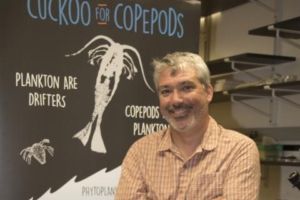Biological oceanographer Jamie Pierson is exploring whether microscopic critters found in the waters around the Chesapeake Bay region could be used to naturally control mosquito populations.

Biological oceanographer Jamie Pierson of the Horn Point Laboratory is exploring whether or not microscopic critters found in the waters around the Chesapeake Bay region could be used to naturally control mosquito populations.
“There are some very serious public health issues around mosquitoes,” said Jamie Pierson, assistant professor at the Horn Point Laboratory (HPL). “We’re trying to find a part of the puzzle to help control mosquitoes without having to spray.”
Copepods—small aquatic crustaceans that are a major food source for small fish and birds—have been used as mosquito control in places like Louisiana and New Jersey. Sometimes they eat the mosquito larvae before they grow into adults or just take a nibble and swim away. Unlike toxic sprays that indiscriminately kill off insects, copepods are a natural and non-toxic method that targets mosquitoes.
As carriers of disease, mosquitoes not only present a public health risk for humans, but they can also present a risk to migratory waterfowl that can transmit disease along their migratory routes and find their food sources decimated by toxic mosquito control agents.
In Maryland, there are 60 species of mosquitoes, and about a third of those have been identified on the Eastern Shore.
“Even if it only works on some—different species are present different times of the year—even to reduce spraying certain times of year would be helpful,” he said. “We’re interested in whether local copepods—ones from Chesapeake Bay—eat our local mosquitoes.”
The pilot project was made possible with seed funding from Waterfowl Chesapeake’s Community in Conservation Fund. It will help Pierson grow local mosquitoes and copepods in the lab to see how they interact, and then figure out how much will it cost to grow enough copepods to ultimately control mosquitoes.
“We want to know how many larvae versus copepods works best. Are they eating them? Are they controlling them?” he said. “Can this be scaled up for municipalities and private entities? If we you can seed ponds with the correct copepods, we may be able to help.”
Credit for this story goes to the News team at UMCES.
